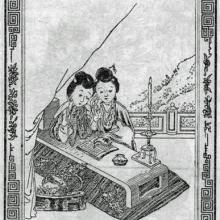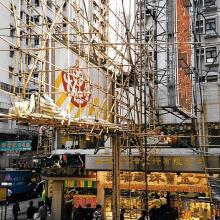Charles Gesner van der Voort (1916-1991) had started his career in Rotterdam, at Holland-China Trading Company (HCHC). In 1938, he went to Shanghai for the firm. The Japanese interned him, and most other Dutch nationals, from 1943-45. In camp, he met his wife Nancy and they married after the war. After a leave in The Netherlands, they returned to the Orient, where Charles continued to work for HCHC in Hong Kong.
Royal Dutch Library has a great site for retrieving printed matter, especially newspapers. Several registrations of trade marks were found in Nederlandse staatscourant (Dutch State Gazette), accompanied by a drawing of the trade mark (Delpher.nl).
Hotz s'Jacob was one of the organisations which preceded Holland-China Trading Company, which was founded in 1903. One of the main products it traded was cotton clothing, produced in the East of the Netherlands, Twente.
The caption reads:
"14449
Naam van den inzender:
De firma Hotz s'Jacob & Co., te Rotterdam.
Soort der waren:
Katoenen manufacturen.
Dagteekening waaronder de inschrijving heeft plaats gehad:
23 januari 1900.
Het merk vertoont in een lijst, gevormd door gouden ruiten op blauwen grond, een Chinees, zittende op een rots met de voeten in het water, de rechterhand uitgestrekt naar een breeder wordenden golf, die uit het water ten hemel stijgt en waarin allerlei visschen, amphibieen en schelpen zijn afgebeeld. Een ander ligt geknield in biddende houding achter hem. De achtergrond wordt gevormd door een heuvelachtig terrein met boomen."
Courtesy Koninklijke Bibliotheek (Royal Dutch Library), Nederlandsche staatscourant, 1 February 1900
This trade mark was also registered in Hong Kong. The 19 January 1901 Hongkong Government Gazette reads:
"The trade marks ordinance, 1898
Application for Registration of Trade Marks.
Notice is hereby given that Messrs. Hotz S'Jacob and Company have, on the 26th day of September 1900, applied for the registration in Hongkong, in the Register of Trade Marks the following Trade Marks:
...
5. The figure of a Chinaman sitting on a rock with his feet in the water. His right hand is stretched out pointing to a woman kneeling beside him as if supplicating him a waterspout with all sorts of fishes, shells, &c.
...
in the name of Hotz S'Jacob and Company, who claim the be the sole proprietors thereof. The Trade Marks are intended to be used by the applicants in the respect of the Cotton Piece Goods of all kinds in Class 24.
Facsimiles of the Trade Marks can be seen at the Office of the Colonial Secretary of Hong Kong and also at the Office of the undersigned.
Dated the 12th day of November, 1900.
Wilkinson & Grist,
Solicitors for the Applicants,
70, Queens Road, Hongkong."
This trademark was transferred to Holland-China Trading Company in 1904.
The Hongkong Government Gazette, 12 August 1904:
"Government notification. - No. 567.
Notice is hereby given that Mrssrs. Hotz s'Jacob & Company have by assignment transferred their nineteen (19) trade marks (15 registered on 20th March, 1901, in respect of Cotton piece goods of all kinds in class 24; 1 registered on 29th November, 1901, in respect of Condensed milk, cocoa and chocolate in Class 42; and 3 registered on 29th November, 1901, in respect of Sewing cotton on spools or reels in Class 23) to the Holland-China Handels Compagnie (Holland-China Trading Company) of Rotterdam in the Kingdom of Holland.
By command,
F.H. May,
Colonial Secretary.
Colonial Secretary's Office, Hongkong, 11th August, 1904."
Courtesy Hong Kong University Library, <a href="https://old.gwulo.com/%3Ca%20href%3D"https://lib.hku.hk/database/">https://lib.hku.hk/database/" rel="noreferrer nofollow">lib.hku.hk/database/</a>





Comments
Re: Two men fishing
Hi There,
This one did not have a Title or the company name. The two charactors look similar to two of the eight dieties in folklore.
T